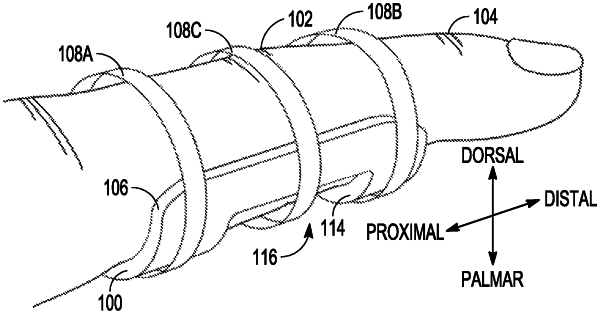| CPC A61F 5/05875 (2013.01) | 19 Claims |

|
1. A splint for immobilizing a proximal interphalangeal (PIP) joint of a finger in a straight position while allowing both a distal interphalangeal (DIP) joint and a metacarpophalangeal (MCP) joint of the finger to be flexed, the splint comprising:
a splint body having a monolithic structure with opposing first and second ends, the splint body having a size configured to fit the finger and having a non-tapered, partial-cylindrical shape before application to the finger, the splint body being rigid or semi-rigid to maintain a shape of a partial cylinder after application to the finger, wherein the non-tapered, partial-cylindrical shape has a longitudinal axis which, when the splint body is applied to the finger, corresponds to a length direction of the finger with the PIP joint in the straight position, the splint body having a concave side configured to receive the finger from a palmar side of the finger and partially surround the finger from the palmar side of the finger, the splint body having a width, extending between first and second side edges of the splint body along lateral and medial sides of the finger, respectively, to partially surround the finger and having a length to extend from a proximal phalanx of the finger across the PIP joint to a middle phalanx of the finger to maintain the finger straight at the PIP joint, wherein the length does not extend across either the DIP joint or the MCP joint;
the monolithic structure of the splint body having a periphery defining a central opening of the splint body, the periphery of the monolithic structure including:
a first base having a first end edge at the first end of the splint body and configured to partially surround the finger from the palmar side at the proximal phalanx of the finger without extending across the MCP joint;
a second base having a second end edge at the second end of the splint body and configured to partially surround the finger from the palmar side at the middle phalanx of the finger without extending across the DIP joint; and
opposing sides, including the first and second edges of the splint body, that extend between the first and second bases and are configured for placement on opposing lateral and medial sides of the finger to maintain the finger straight at the PIP joint, wherein the first base, the second base and the opposing sides of the monolithic structure provide the non-tapered, partial cylindrical shape of the splint body, and both the first base and the second base having a cross section, taken perpendicular to the longitudinal axis, in a shape of a partial circle, wherein the splint body is uniformly thick throughout the first base, the second base and the opposing sides, and the splint body has an inner surface, on the concave side, equidistant from the longitudinal axis and has an outer surface equidistant from the longitudinal axis and to provide the non-tapered, partial cylindrical shape, wherein a plane parallel to the longitudinal axis is tangential to the outer surface of the first base from the first end edge to the central opening and tangential to the outer surface of the second base from the central opening to the second end edge, and wherein when the splint body is applied to the finger the plane is on the palmar side of the finger and the inner surface of the second base in the shape of the partial circle contacts the finger at or near the medial and lateral sides of the middle phalanx and is spaced from the palmar side of the middle phalanx at the second end edge when the distal interphalangeal joint is in extension and the first and second bases are not turned on the proximal and middle phalanx, respectively; and
straps configured to wrap around a dorsal side of the finger to secure the splint body to the finger, the straps including:
at least a first strap attached to the first base and configured for use to wrap around the proximal phalanx of the finger without wrapping around the MCP joint;
at least a second strap attached to the second base and configured for use to wrap around the middle phalanx of the finger without wrapping around the DIP joint; and
at least a third strap attached to at least one of the opposing sides between the first base and the second base, and configured for use to wrap around the finger.
|